Podcast Daily Routines
A diary study to better understand what role podcasts play in listeners’ daily lives and routines
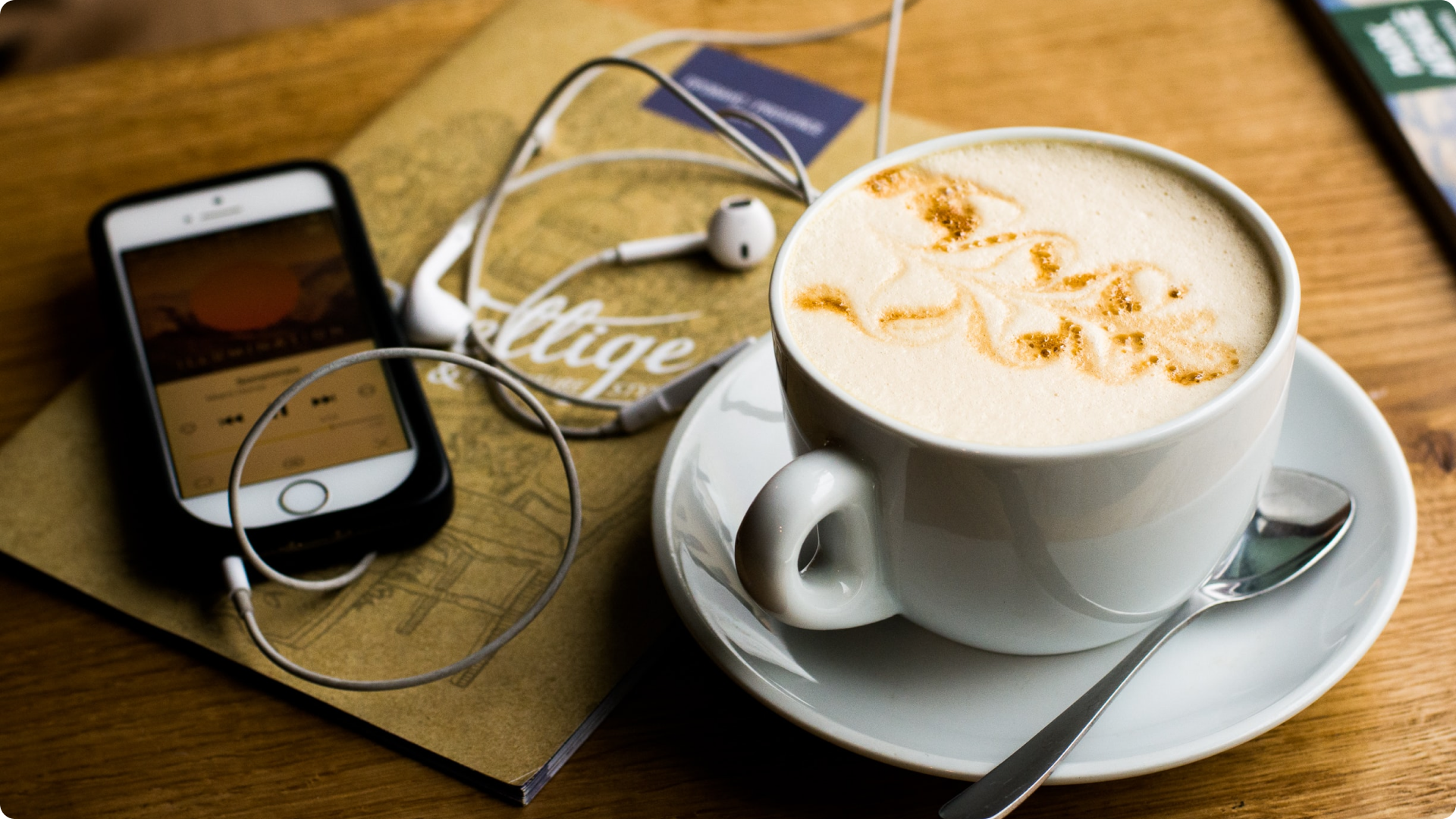
Overview
Team: Caroline Gomez, Haasini Sai P, Hailee Kenney, Nisha Jain, Xuny Haley
Role: Researcher
Project Timeline: 8 Weeks
Number of Participants: 5
Research Methods: Diary study, semi-structured interviews
Podcast listenership has grown in recent years. According to Edison Research, 80 million Americans are weekly podcast listeners as of a report published in March 2021, up from 68 million in 2020. This is in spite of, or perhaps even caused by, the disruptions to many people’s lives that came with the COVID-19 pandemic. From delivering daily news updates to enriching a monotonous commute, podcasts fulfill a variety of needs for listeners. Despite their popularity, there are few refined best practices or guidebooks for producing podcasts like there are for media like books and film. Inspired by the work of one of our team’s researchers, a longtime podcast producer for KUOW, we set out to examine the lives, habits and preferences of podcast listeners in an effort to help podcast creators create content that fit users’ needs, constraints and interests.
Due to a desire to examine the specific details of listeners' daily routines, we conducted a dairy study where participants submitted daily surveys and audio logs exploring their listening habits. After analyzing the available data, we came away with several interesting trends for podcast producers to consider. We found that podcasts are companions for listeners' daily lives, and both listening time and focus level are at the mercy of individual schedules. While listeners do turn to podcasts for content and information, they also turn to them to enhance a desired mood, emotional state, or “vibe”. Ultimately, there are opportunities for podcast producers to consider their audience and the needs that their podcast can meet for potential listeners.
Research Questions
Based on some informal exploratory research and literature review, we chose to address the following research questions through this study:
- How do podcasts serve podcast listeners’ needs and why?
- How can podcast creators design podcasts to better suit listeners?
- How do podcasts fit within users’ schedules?
- What limitations do podcast listeners face?
Methodology
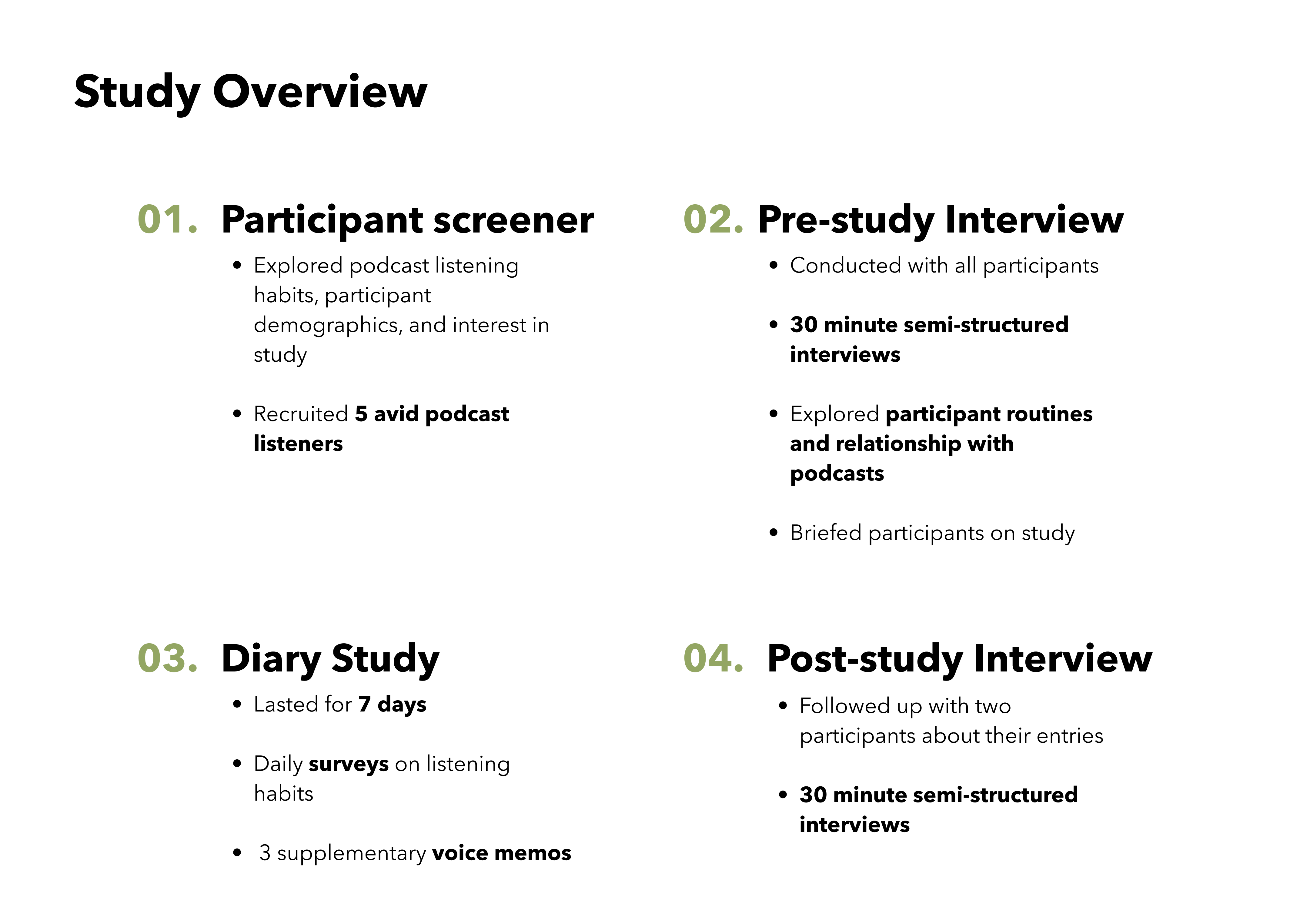 Participants
Participants
To recruit participants we created a screener exploring participant listening habits, demographics, and interest in participating in the study. Due to time and budget constraints we recruited from our personal networks at a podcast listserv. We chose to work with participants who were all avid listeners (listened more than 3 times per week) and also tried as much as possible to have a mix of gender and racial diversity.
Pre-study InterviewsTo create a profile of each participant, we conducted semi-structured pre-study interviews to understand their existing relationship with podcasts. The interview explored what types of podcasts participants enjoyed, how they tended to listen, and how podcasts fit into their routine. We also used this opportunity to brief them on the study.
Diary StudyThe diary study lasted for a total of 7 days. Every participant was sent a daily email reminder to complete a survey which addressed their podcast listening habits for that day - for example, what podcasts they listened to and when, their focus level while listening to podcasts, how they felt while listening, etc. In addition to daily surveys, participants were asked to submit at least three supplementary voice memos over the course of the study in response to the prompt:
“While you were listening to your podcast tell us about the range of emotions you felt. This could be related to the episode, or it could be feelings toward something that occurred at the same time while you were listening to the episode.”
Post-Study InterviewsFor some participants, we reached out for a 30-minute semi-structured post-study interview to better understand their listening habits over the course of the study. We chose not to interview all participants due to time constraints, and focused on participants whose survey responses and unique listening habits we wanted to better understand.
Data Analysis
- Qualitative Data: Once we had finished collecting our participant data, we began performing emergent coding on all diary form entries and the transcripts of participant voice memos. As codes were identified we solidified a codebook, which we used to fully analyze the entries from all five participants. Once coding was completed we performed a thematic analysis using the coded data to identify findings.
- Quantitative Data: We also explored quantitative data both through participant survey responses and by analyzing the number of times particular codes appeared. We took averages of daily listening times and self-reported focus levels, and, based on code frequency, measured how often participants would listen while doing particular activities or how often participants would engage with particular types of podcasts.
Insights
Insight One: Podcasts are uniquely suited to accompany other tasks
Unlike other forms of media like books, film, or TV, podcasts do not require listeners’ full attention and are perfect aids for multitasking. Throughout the study, participants almost exclusively listened to podcasts while doing something else, including driving, cooking dinner, or making art. Throughout the study, participants reported an average podcast focus level of 3.9/5. There were very few instances where participants were exclusively listening to podcasts and devoting their full attention. Not only were participants able to listen to podcasts while doing something else, podcasts were also assistive - listening to a podcast at the same time sometimes made it easier for participants to accomplish other tasks.
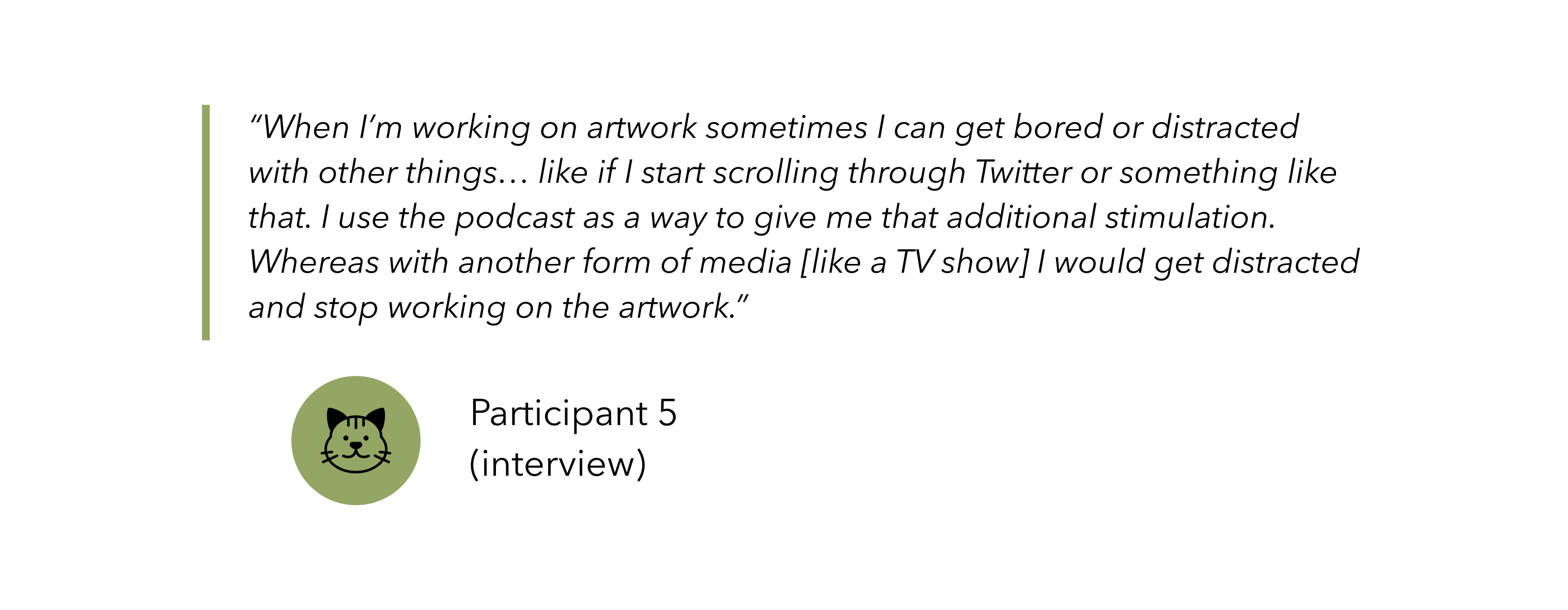
Insight Two: Podcast listeners engage with podcasts between major activities
Due to the ease of listening, podcasts often fill in the gaps in listeners’ days and are most commonly listened to before or after major activities take place. Participants listen to podcasts while commuting, while getting ready in the morning, and between meetings.

Insight Three: Podcast listenership is at the mercy of listeners’ daily schedules
Participants listened to podcasts within the confines of their daily schedules. If they became too busy, they were unable to listen to podcasts - this was true for over half of participants, whose schedules were prone to to change, interruption, and inconsistency. Listeners' predictions on their next day podcast routine ranged from 20% - 60% accurate, and participants also could not always predict what might derail their plans.
Insight Four: Podcasts facilitate vibes
Podcasts do not only serve as a means to convey information or provide entertainment. Podcasts are also a tool that people utilize to enhance a desired mood or emotion. This “enhancement” is personal and varies from individual to individual, but each participant chose podcasts in order to derive specific emotions or evoke an environment conducive to their desired activity. This included but was not limited to a feeling of companionship, a sense of comfort, or creating the right atmosphere to allow participants to fall asleep or work on projects.
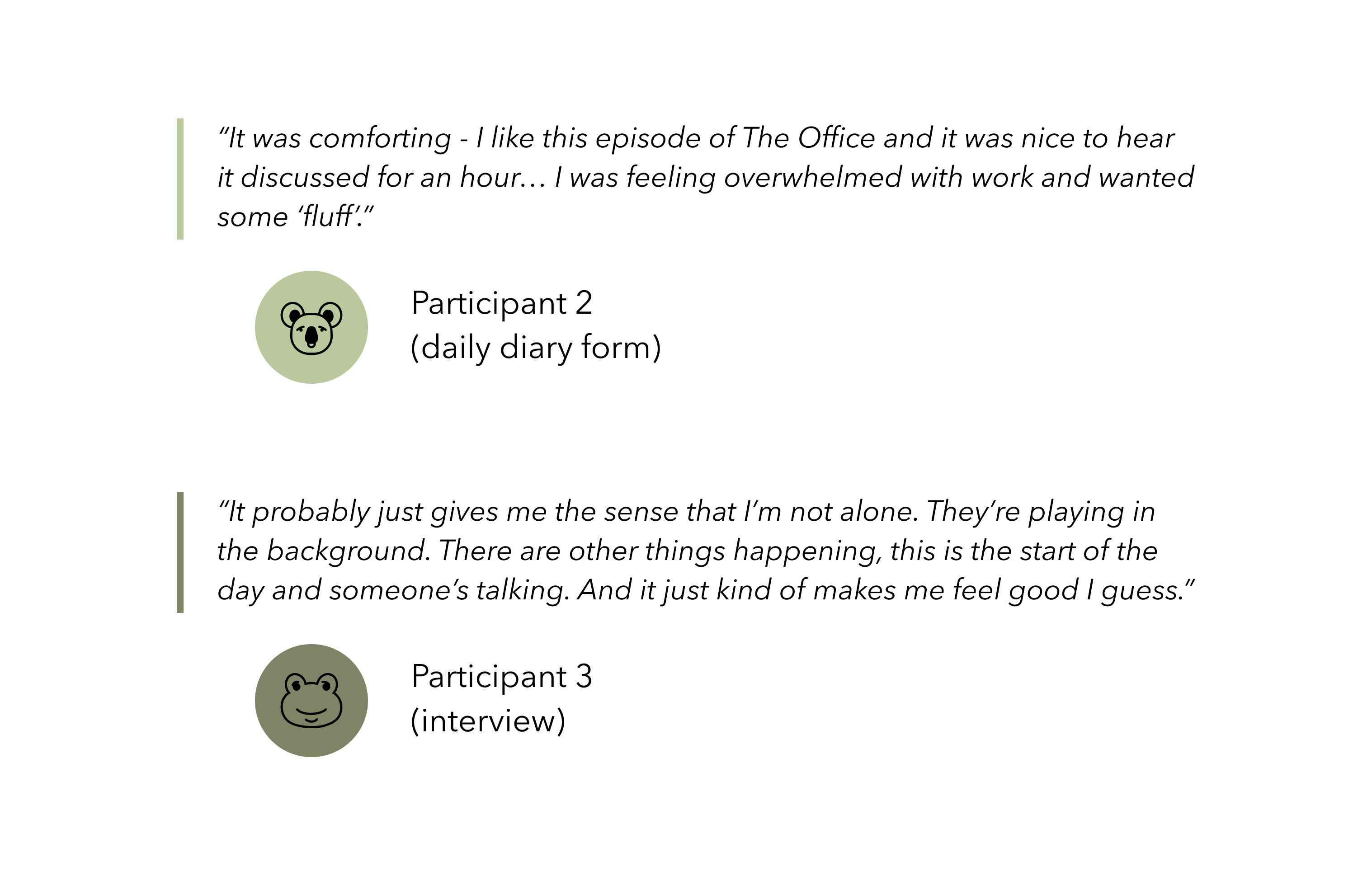
Insight Five: Podcasts fulfill multiple needs for listeners
Each participant had various motivations to regularly listen to podcasts. Some of those motivations were content-specific, and others were emotion-specific. These needs were variable and highly personal to the specific listener, ranging from keeping up on current events to personal enrichment to seeking comfort. There are opportunities for podcast creators to not just consider the target audience when creating podcasts, but to have a deeper understanding of the various goals podcast listeners have, as well as how their podcast could help fulfill those goals.
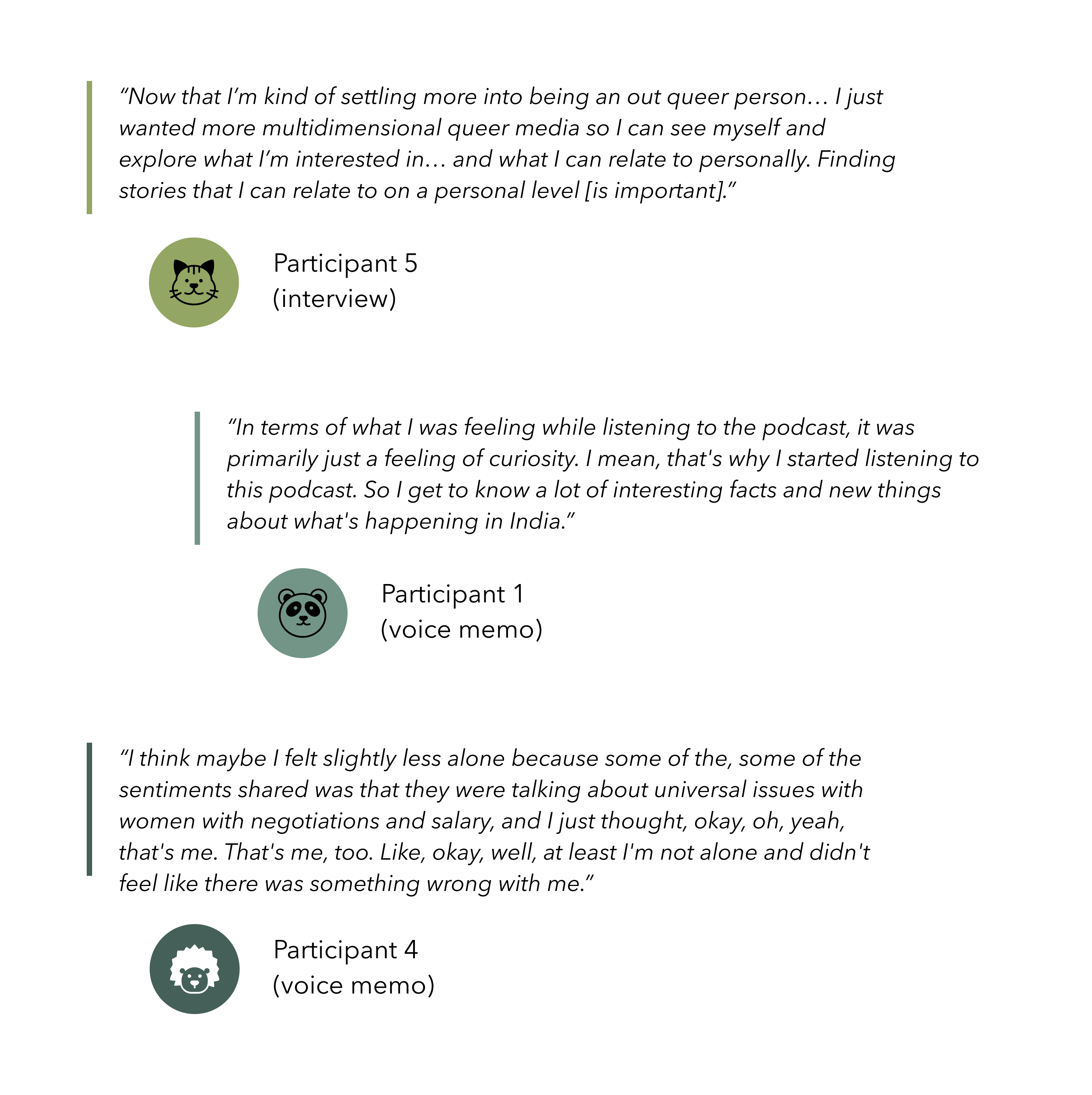
Implications for Podcast Creators
Based on these results, some valuable questions for podcast creators to ask themselves when designing content may be -
- In what context are listeners usually engaging with the podcast? Throughout the study we saw that podcast listenership is both sporadic and volatile. Listeners generally do not give content their undivided attention, frequently pause episodes, and listen only as their schedules allow, which can at times be unpredictable. This means that a show designed to be consumed with complete focus in one 60 minute session may not be optimal for most listeners.
- Who is the target audience of this podcast and what are their needs? During the study, participants actively chose podcasts that augmented a desired feeling or sensation in line with their goals. Podcasts creators should identify the specific, tangible needs of the personas they are creating for, and design content that is tailored to those needs.
- How can podcasts serve needs beyond delivering information? Participants throughout the study used podcasts to assist them in tasks or facilitate the creation of a particular mood. How might podcasts help listeners combat feelings of loneliness? How might they help listeners fall asleep? How might they help artists focus on their work?
Reflection
Due to time constraints and available resources, there were significant limitations on the scope of this study. Based on these limitations and lessons learned, here are some considerations for the study if it were to continue.
- Include beginner or casual listeners in the study. We chose only to work with avid podcast listeners, which meant that we missed an opportunity to explore the journey of podcast discovery and integration for new listeners.
- Collect data that allows pinpointing which genres assist with particular tasks. While we identified that podcasts assist with things like falling asleep or companionship, we were unable to identify which types of podcasts are best suited for particular activities.
- Conduct a longer study to more authentically explore how routines and disruptions impact podcast listening. One week is not a large enough scope to gain a full understanding of participant listening routines or get an authentic picture of how routines change over time. Participants also adapted their listening for the sake of the study.
- Explore other forms of audio entertainment such as audio books. Compare and contrast how other forms of audio entertainment fit into listeners’ lives relative to podcasts.
- Follow up with participants about surveys on the same day to avoid recall bias. Researchers did not review diary entries as they came in, and by the time post-study interviews were conducted, it had been several weeks since participants had made the entries. To collect more accurate data, researchers should read entries as they come in and, if they have questions, follow up with participants as soon as possible.